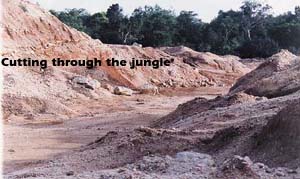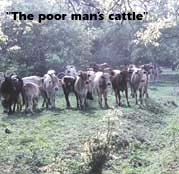 |
 3rd May 1998 |
Front Page| |
Burning IssuesA pristine forest is endangered. Taya Diaz writesWhere is Polonnaruwa nature sanctuary?The other day I happened to see something amusing. A concrete plaque, erected by the British in 1938, being given a thorough white washing. Engraved letters, touched in black paint, boldly stood-out to read in English, Sinhala and Tamil:
The amusing thing about it is - Where is the sanctuary? The occasion for the refurbishment of the old plaque was the ceremonial opening of a row of vegetable stalls for the town of Kaduruwela and this plaque that happened to be a bystander right next to the door of a new stall got a bit of the wash of the ceremony as well. Not that the occasion meant anything "green." How can it be, for the sanctuary lies 5 km away? The spot merely marks a corner of the sanctuary that was here half a century ago. Welcome to conservation, the Sri Lankan way! Today the sanctuary stands at only 3 sq.km. one fifth the range that was declared by the British. The travails of the Polonnaruwa Nature Sanctuary, its official title today, are not limited to shrinkage alone. On a daily basis, it is plagued with over a score of injurious attacks. It will not be too long before this nugget of wild glory is swiped out of the plains of Polonnaruwa should this harmful trend continue. Let me cite a few recent happenings. Just within days a bulldozer peeled a swathe of jungle and ploughed and harrowed the sod beneath it for, of all things, a road fill! Fallow land, acres of it, was abutting this very spot- not even a glance that way. Now that the jungle is wiped off, I hear whispers of more ambitious plans-to set up some kind of factory.
In this small sanctuary alone there are 1,500 heads of cattle, and the figure is rising. The cattle graze not only the grass but also the forest vegetation away as well, particularly the seedlings and saplings. In drought times when their staple, grass, is in short supply, this tendency is even greater. Walk in, and the result is to be seen all over - bare patches that are totally devoid of forest vegetation. What a price the sanctuary has to pay for the upkeep of the cattle of the poor! Having worked in these jungles for the last eighteen years, I see even more alarming damage. Up to the early eighties it was customary to see frolicsome flocks of grass seed eating birds in this sanctuary-such as Munias and Weavers. With the waving flower heads gone, gone are these birds as well. They were cruelly deprived of the sanctuary, the only refuge they had. Last year, Polonnaruwa underwent a severe drought. Trees, particularly Wa and Ahala, in areas subjected to intense grazing, suffered the most and some died as a direct result of it. With the blessings of October rains these trees burst out into flush, only to be infested with caterpillars in their customary zillions to feast on the bounty of leaf shoots, and within days, transforming the trees back to the twiggery that drought had brought upon them. Unable to cope with this double blow another set of trees began dying. The sanctuary is also an Archaeological Reserve with some of the best of Sri Lanka's ancient monuments and statuary of to be seen. Tourists throng here at all times of the year; peaking on poya days with devout Buddhists fulfilling their religious observances. Wherever humans gather, for prayer or play, so gathers garbage; and these religious sites are no exceptions. The precincts of Watadage, Rankoth Vehera and Galviharaya are permanent dumpyards of garbage. Recently these religious and archaeological sites were declared as a world heritage sites by UNESCO. It is hard to fathom what exactly that means when one considers how the reeking waste water of paddy mills is allowed to run right across the sanctuary. Finally, saying that paoching and felling is also rampant here, I will stop my harangue to consider something of even more importance. Now this is an area, as you all know, of just 3 sq.km. A droplet of forest. To manage it, there is, first and foremost, the archaeological office, situated within the sanctuary. Most of the staff, too, are quartered within the sanctuary. Then comes the UNESCO funded Cultural Triangle project, which because of the tonnage of funding recently, is by far the more active office, regarding the affair of the sanctuary. They, too, are in the vicinity. Likewise the WildLife Office, Forest Office, Pradeshiya Sabha, the Police, Divisional Secretariat, the District Secretariat Departments and Authorities that have some claim in the management of the Sanctuary, albeit in various degrees, are within a mile or two of the Sanctuary. That is a lot of Departments, a lot of personnel at a local level to manage one tiny sanctuary. Yet it is not managed. What then, is needed to present a positive picture? To get all to act in concert? The catalyst, in a sense, to start the reaction within this cauldron of Departments? "Burning Issues" will deal with it in detail later. Until then give it a thought. A deep thought for a vanishing sanctuary. Remember, preservation is all about pooled effort. You may pool in your thoughts and ideas to: "Burning Issues," The Sunday Times.... |
||
 |
More Plus * Serendib at the gallery
Front Page| News/Comment| Editorial/Opinion| Business| Sports | Mirror Magazine |
|
 |
Please send your comments and suggestions on this web site to |
|
 Polonnaruwa
Sanctuary. Hunting and shooting is prohibited
Polonnaruwa
Sanctuary. Hunting and shooting is prohibited Getting
cattle to graze in protected forest is now a practice that is taken for
granted. Even officials are of the view that there is no real harm in it,
and they justify it by claiming: after all, it is the cattle of the poor.
Getting
cattle to graze in protected forest is now a practice that is taken for
granted. Even officials are of the view that there is no real harm in it,
and they justify it by claiming: after all, it is the cattle of the poor.